Antiviral Antiviral Antivirals for Hepatitis B agents against influenza Influenza Influenza viruses are members of the Orthomyxoviridae family and the causative organisms of influenza, a highly contagious febrile respiratory disease. There are 3 primary influenza viruses (A, B, and C) and various subtypes, which are classified based on their virulent surface antigens, hemagglutinin (HA) and neuraminidase (NA). Influenza typically presents with a fever, myalgia, headache, and symptoms of an upper respiratory infection. Influenza Viruses/Influenza are important in preventing and treating influenza Influenza Influenza viruses are members of the Orthomyxoviridae family and the causative organisms of influenza, a highly contagious febrile respiratory disease. There are 3 primary influenza viruses (A, B, and C) and various subtypes, which are classified based on their virulent surface antigens, hemagglutinin (HA) and neuraminidase (NA). Influenza typically presents with a fever, myalgia, headache, and symptoms of an upper respiratory infection. Influenza Viruses/Influenza infection. Influenza Influenza Influenza viruses are members of the Orthomyxoviridae family and the causative organisms of influenza, a highly contagious febrile respiratory disease. There are 3 primary influenza viruses (A, B, and C) and various subtypes, which are classified based on their virulent surface antigens, hemagglutinin (HA) and neuraminidase (NA). Influenza typically presents with a fever, myalgia, headache, and symptoms of an upper respiratory infection. Influenza Viruses/Influenza is often self-limited, but high-risk populations suffer significant morbidity Morbidity The proportion of patients with a particular disease during a given year per given unit of population. Measures of Health Status and mortality Mortality All deaths reported in a given population. Measures of Health Status from the illness. Different classes of drugs act on the influenza Influenza Influenza viruses are members of the Orthomyxoviridae family and the causative organisms of influenza, a highly contagious febrile respiratory disease. There are 3 primary influenza viruses (A, B, and C) and various subtypes, which are classified based on their virulent surface antigens, hemagglutinin (HA) and neuraminidase (NA). Influenza typically presents with a fever, myalgia, headache, and symptoms of an upper respiratory infection. Influenza Viruses/Influenza virus Virus Viruses are infectious, obligate intracellular parasites composed of a nucleic acid core surrounded by a protein capsid. Viruses can be either naked (non-enveloped) or enveloped. The classification of viruses is complex and based on many factors, including type and structure of the nucleoid and capsid, the presence of an envelope, the replication cycle, and the host range. Virology. Neuraminidase inhibitors include oseltamivir (oral), zanamivir (inhalation) and peramivir (IV); these drugs act by inhibiting neuraminidase, the enzyme that cleaves off the new virus Virus Viruses are infectious, obligate intracellular parasites composed of a nucleic acid core surrounded by a protein capsid. Viruses can be either naked (non-enveloped) or enveloped. The classification of viruses is complex and based on many factors, including type and structure of the nucleoid and capsid, the presence of an envelope, the replication cycle, and the host range. Virology particle. By blocking the enzymatic effect, further release of progeny virus Virus Viruses are infectious, obligate intracellular parasites composed of a nucleic acid core surrounded by a protein capsid. Viruses can be either naked (non-enveloped) or enveloped. The classification of viruses is complex and based on many factors, including type and structure of the nucleoid and capsid, the presence of an envelope, the replication cycle, and the host range. Virology to nearby respiratory cells is reduced. Baloxavir, a selective inhibitor of influenza Influenza Influenza viruses are members of the Orthomyxoviridae family and the causative organisms of influenza, a highly contagious febrile respiratory disease. There are 3 primary influenza viruses (A, B, and C) and various subtypes, which are classified based on their virulent surface antigens, hemagglutinin (HA) and neuraminidase (NA). Influenza typically presents with a fever, myalgia, headache, and symptoms of an upper respiratory infection. Influenza Viruses/Influenza cap-dependent endonuclease, inhibits viral mRNA mRNA RNA sequences that serve as templates for protein synthesis. Bacterial mRNAs are generally primary transcripts in that they do not require post-transcriptional processing. Eukaryotic mRNA is synthesized in the nucleus and must be exported to the cytoplasm for translation. Most eukaryotic mRNAs have a sequence of polyadenylic acid at the 3' end, referred to as the poly(a) tail. The function of this tail is not known for certain, but it may play a role in the export of mature mRNA from the nucleus as well as in helping stabilize some mRNA molecules by retarding their degradation in the cytoplasm. RNA Types and Structure synthesis Synthesis Polymerase Chain Reaction (PCR). Both neuraminidase inhibitors and baloxavir have activity against influenzas A and B. Adamantanes, or M2 inhibitors, include amantadine and rimantadine, which are active against influenza Influenza Influenza viruses are members of the Orthomyxoviridae family and the causative organisms of influenza, a highly contagious febrile respiratory disease. There are 3 primary influenza viruses (A, B, and C) and various subtypes, which are classified based on their virulent surface antigens, hemagglutinin (HA) and neuraminidase (NA). Influenza typically presents with a fever, myalgia, headache, and symptoms of an upper respiratory infection. Influenza Viruses/Influenza A but are not often used owing to resistance Resistance Physiologically, the opposition to flow of air caused by the forces of friction. As a part of pulmonary function testing, it is the ratio of driving pressure to the rate of air flow. Ventilation: Mechanics of Breathing.
Last updated: Dec 15, 2025
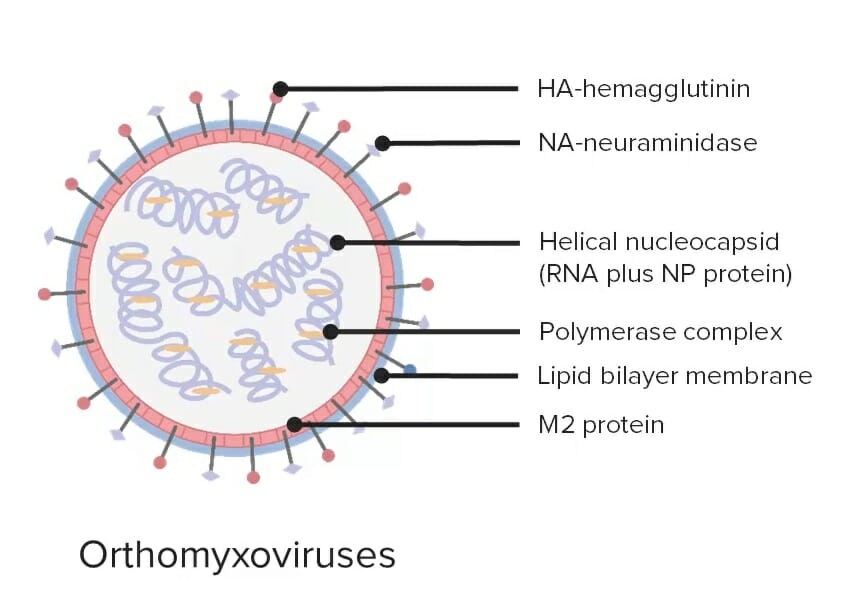
A diagram of the structure of the Influenza virus.
Image by Lecturio.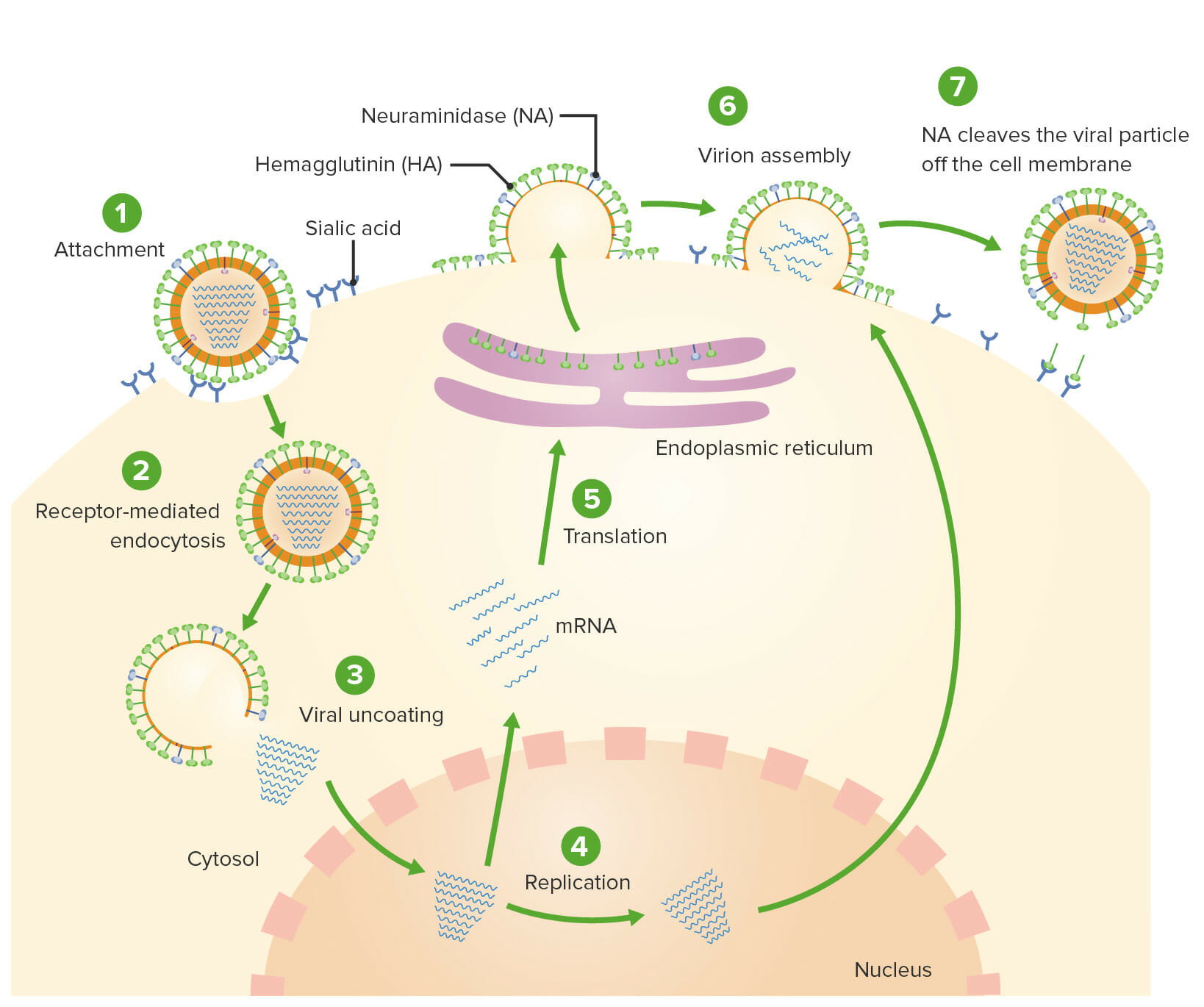
Influenza virus replication:
1: A viral particle attaches its hemagglutinin (HA) spikes to sialic acid-containing receptors on the surface of respiratory epithelial cells.
2: The viral particle is internalized via receptor-mediated endocytosis.
3: Once inside the cell, the M2 protein acts as an ion channel, allowing an influx of hydrogen particles, which results in uncoating of the virus.
4: The viral RNA then moves into the nucleus of the cell, where it is replicated and messenger RNA is synthesized.
5: The mRNA is then translated into new viral proteins using the cellular machinery.
6: Viral particles and newly replicated RNA are brought to the surface of the cell and assembled into virions.
7: As the new virus buds off of the respiratory epithelial cells, the hemagglutinin again binds to the sialic acid-containing receptors. The neuraminidase (NA) then cleaves the new viral particle off of the respiratory epithelial cell so it can go infect nearby cells.
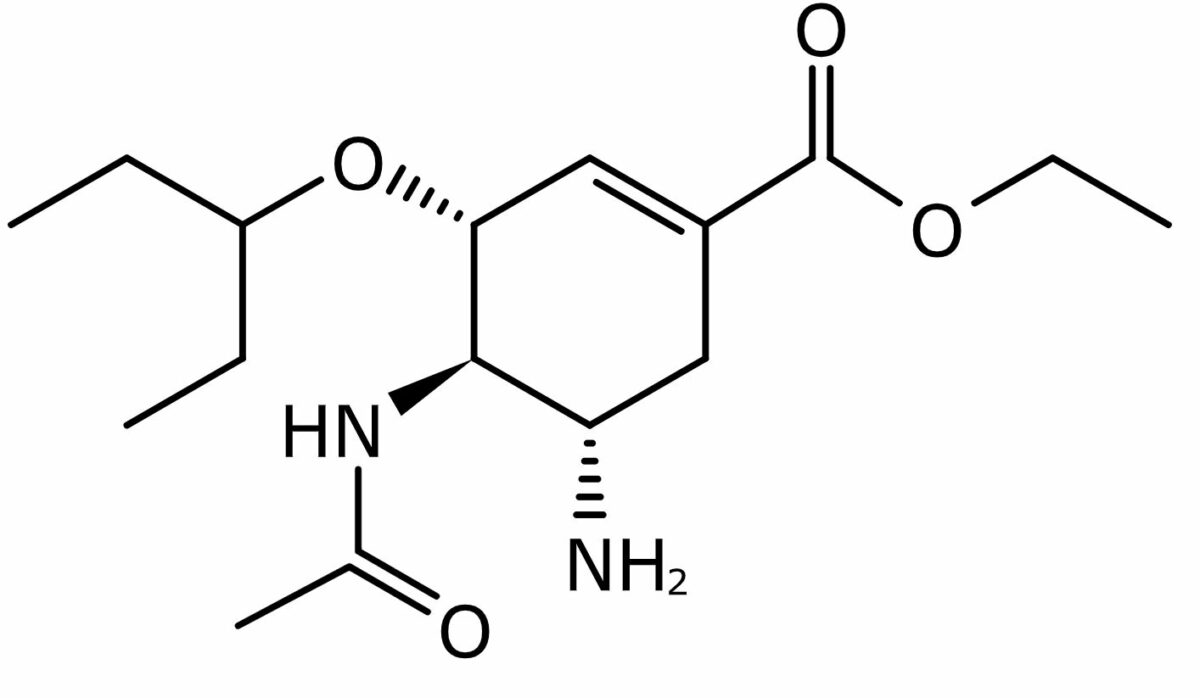
Oseltamivir, a neuraminidase inhibitor
Image: “Oseltamivir” by BartVL71. License: Public Domain
Peramivir, a neuraminidase inhibitor
Image: “Peramivir” by Fvasconcellos. License: Public Domain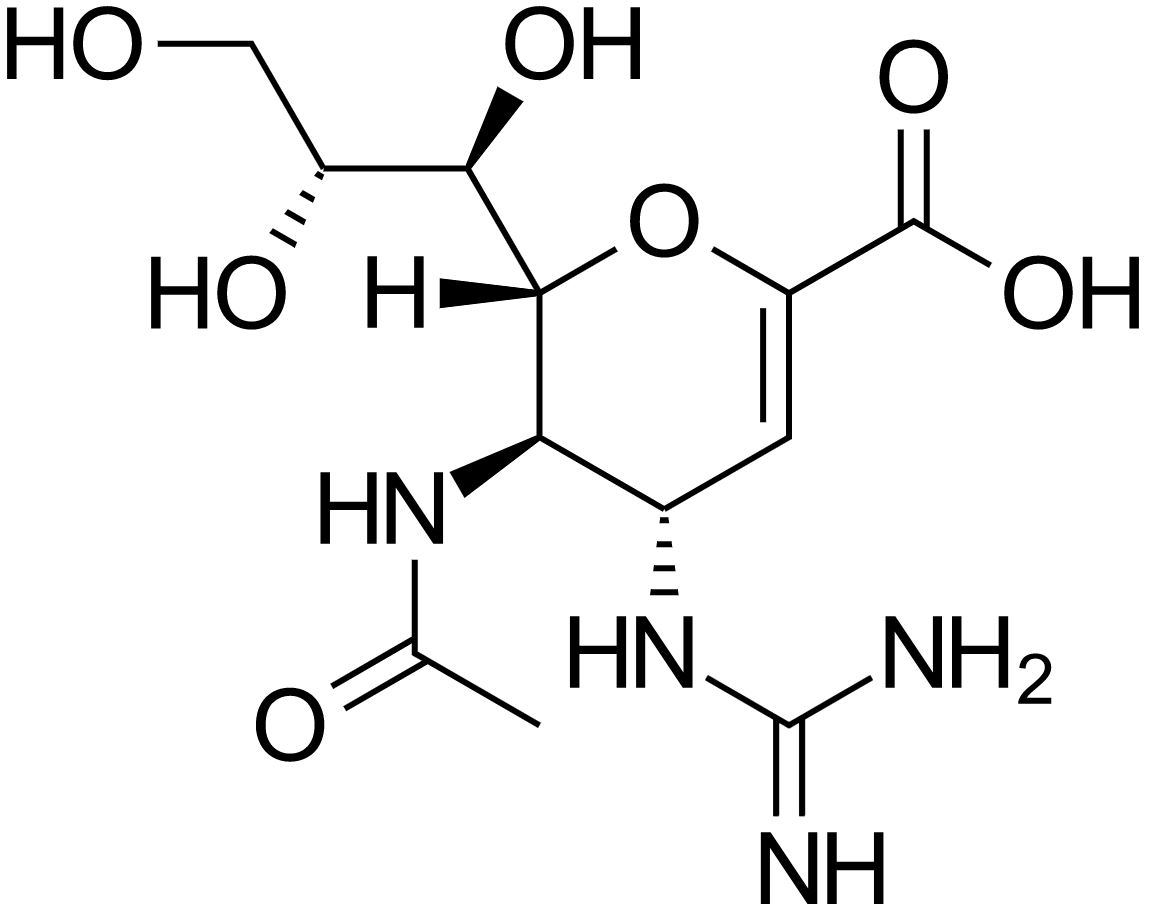
Zanamivir, a neuraminidase inhibitor
Image: “Zanamivir structure” by Vaccinationist. License: Public Domain| Category | Oseltamivir | Peramivir | Zanamivir |
|---|---|---|---|
| Absorption Absorption Absorption involves the uptake of nutrient molecules and their transfer from the lumen of the GI tract across the enterocytes and into the interstitial space, where they can be taken up in the venous or lymphatic circulation. Digestion and Absorption |
|
|
Inhalation |
| Distribution |
|
|
|
| Metabolism | No significant metabolism | ||
| Excretion |
|
|
Up to 15% absorbed and excreted in the urine |
| Oseltamivir | Peramivir | Zanamivir | |
|---|---|---|---|
| Adverse effects |
|
|
|
| Contraindications Contraindications A condition or factor associated with a recipient that makes the use of a drug, procedure, or physical agent improper or inadvisable. Contraindications may be absolute (life threatening) or relative (higher risk of complications in which benefits may outweigh risks). Noninvasive Ventilation |
|
|
|
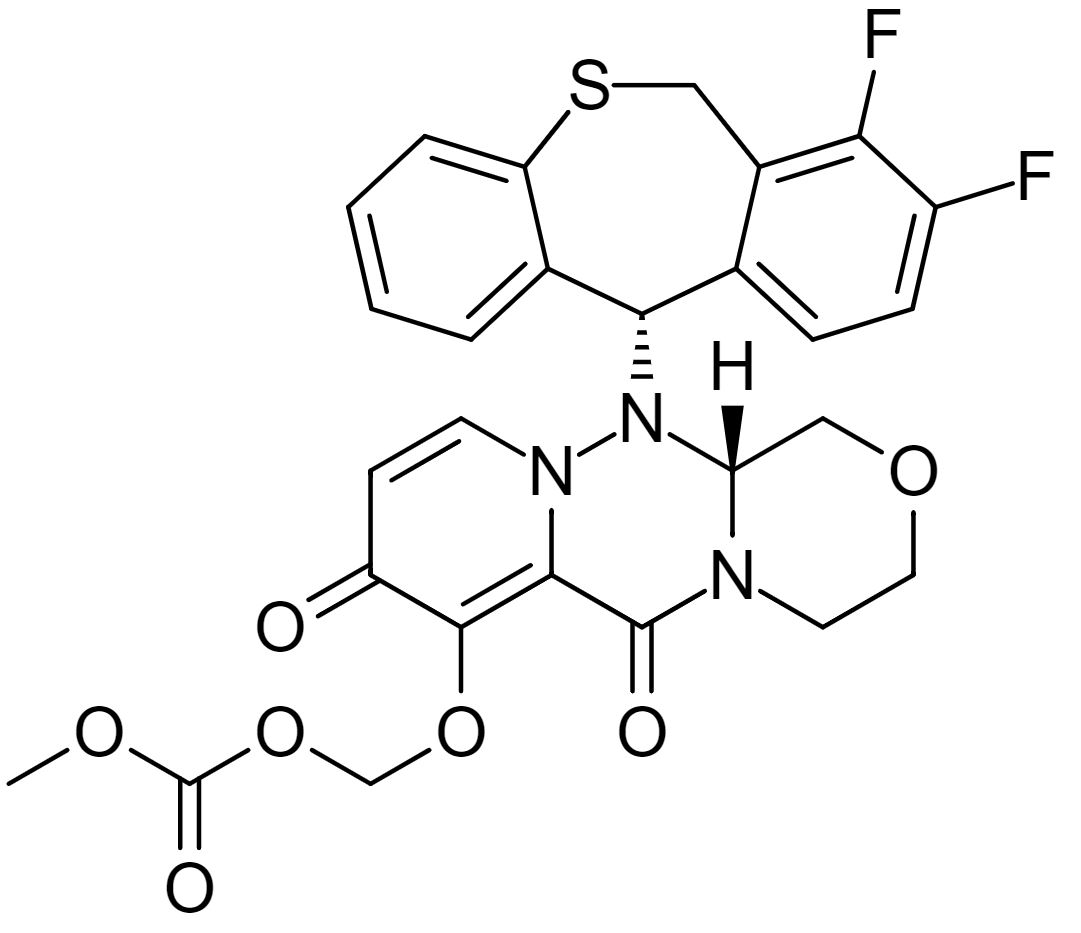
Chemical structure of baloxavir
Image: “Baloxavir marboxil” by Ed. License: Public Domain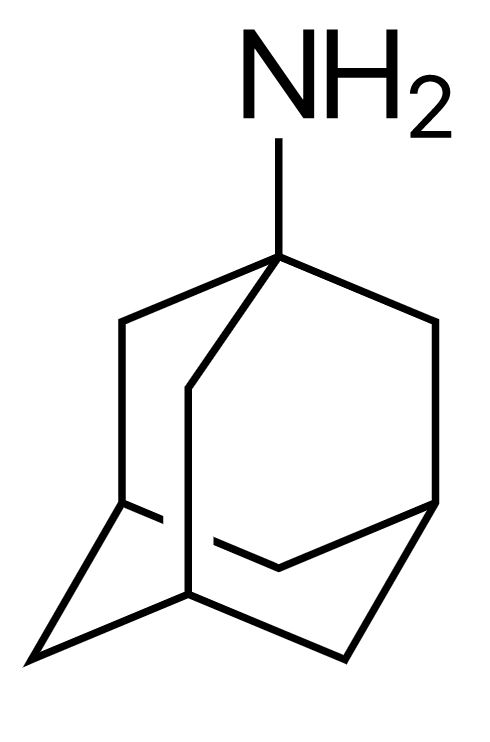
Structure of amantadine
Image: “Amantadine” by Ayacop. License: Public Domain| Category | Amantadine | Rimantadine |
|---|---|---|
| Absorption Absorption Absorption involves the uptake of nutrient molecules and their transfer from the lumen of the GI tract across the enterocytes and into the interstitial space, where they can be taken up in the venous or lymphatic circulation. Digestion and Absorption | Good oral bioavailability Bioavailability Pharmacokinetics and Pharmacodynamics | Good oral bioavailability Bioavailability Pharmacokinetics and Pharmacodynamics |
| Distribution |
|
|
| Metabolism | No significant metabolism | Undergoes hepatic metabolism |
| Excretion | Renal (excreted unchanged) | Renal |
| Neuraminidase inhibitors | Baloxavir | Amantadine | |
|---|---|---|---|
| Mechanism of action | Inhibits neuraminidase, preventing spread to uninfected cells | Endonuclease inhibitor, preventing mRNA mRNA RNA sequences that serve as templates for protein synthesis. Bacterial mRNAs are generally primary transcripts in that they do not require post-transcriptional processing. Eukaryotic mRNA is synthesized in the nucleus and must be exported to the cytoplasm for translation. Most eukaryotic mRNAs have a sequence of polyadenylic acid at the 3′ end, referred to as the poly(a) tail. The function of this tail is not known for certain, but it may play a role in the export of mature mRNA from the nucleus as well as in helping stabilize some mRNA molecules by retarding their degradation in the cytoplasm. RNA Types and Structure synthesis Synthesis Polymerase Chain Reaction (PCR) | Prevents M2 channel activity, inhibiting viral uncoating Uncoating Intracellular step that follows virus internalization during which the viral nucleic acid and capsid are separated. Virology |
| Absorption Absorption Absorption involves the uptake of nutrient molecules and their transfer from the lumen of the GI tract across the enterocytes and into the interstitial space, where they can be taken up in the venous or lymphatic circulation. Digestion and Absorption |
|
Oral | Oral |
| Elimination Elimination The initial damage and destruction of tumor cells by innate and adaptive immunity. Completion of the phase means no cancer growth. Cancer Immunotherapy | Renal | Biliary excretion | Renal |
| Indications | Prevention and treatment of influenzas A and B | Prevention and treatment of influenzas A and B | Treatment and prophylaxis Prophylaxis Cephalosporins of influenza Influenza Influenza viruses are members of the Orthomyxoviridae family and the causative organisms of influenza, a highly contagious febrile respiratory disease. There are 3 primary influenza viruses (A, B, and C) and various subtypes, which are classified based on their virulent surface antigens, hemagglutinin (HA) and neuraminidase (NA). Influenza typically presents with a fever, myalgia, headache, and symptoms of an upper respiratory infection. Influenza Viruses/Influenza A (use limited owing to resistance Resistance Physiologically, the opposition to flow of air caused by the forces of friction. As a part of pulmonary function testing, it is the ratio of driving pressure to the rate of air flow. Ventilation: Mechanics of Breathing) |
| Notable adverse effects |
|
Diarrhea Diarrhea Diarrhea is defined as ≥ 3 watery or loose stools in a 24-hour period. There are a multitude of etiologies, which can be classified based on the underlying mechanism of disease. The duration of symptoms (acute or chronic) and characteristics of the stools (e.g., watery, bloody, steatorrheic, mucoid) can help guide further diagnostic evaluation. Diarrhea | CNS side effects |